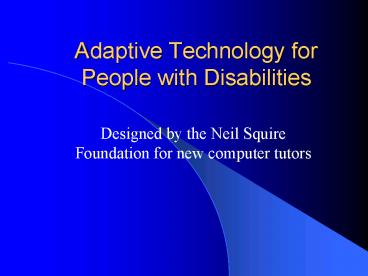Adaptive Technology for People with Disabilities - PowerPoint PPT Presentation
1 / 20
Title:
Adaptive Technology for People with Disabilities
Description:
vision aids (screen magnification, larger text) ... Screen magnification/reading software assist people with little or no vision ... – PowerPoint PPT presentation
Number of Views:69
Avg rating:3.0/5.0
Title: Adaptive Technology for People with Disabilities
1
Adaptive Technology for People with Disabilities
- Designed by the Neil Squire Foundation for new
computer tutors
2
Overview
- Step 1 Identify Adaptive Technology Requirements
- Step 2 Setup appropriate technology
- Step 3 Train client to use technology
- Step 4 Use tutoring resources
3
Step 1 Identify Adaptive Technology Requirements
- Each client has individual needs based on their
disability. - Ask client about their accessibility needs. Do
they require - vision aids (screen magnification, larger text)
- typing aids (voice recognition software, word
prediction software, ergonomic keyboard) - Seating (ergonomic chair)
4
Step 2 Setup Adaptive Technology
- Screen magnification/reading software assist
people with little or no vision - An Onscreen Keyboard assists people with a typing
difficulty or limited movement
5
Windows Magnifier
This magnification software splits the screen in
half whereby the top window follows the cursor.
6
ZoomText
- ZoomText on the other hand is a full screen
magnifier which also includes a screen reader
7
Accessibility Keyboard Settings
- Sticky Keys allows you to use Shift, Ctrl, or
the Alt key by pressing one key at a time. - E.g. in using the shift key, when making capital
letters, instead of holding the shift key down
and typing the letter just hit the shift key
once, then type the letter. - Filter Keys ignores brief or repeated
keystrokes - Toggle Keys enables tones when pressing Caps
Lock, Num Lock, and Scroll Lock
8
Accessibility Sound Settings
- Use Sound Sentry if you want windows to
generate visual warnings when your system makes a
sound. - Use Show Sounds to tell your programs to
display captions for the speech and sounds they
make
9
Accessibility Display Settings
- Use High Contrast settings if you want windows
to use colours and fonts designed for easy
reading.
Windows Standard Scheme
High Contrast Black Scheme
10
Accessibility Mouse Settings
- Use Mouse Keys if you want to control the
pointer with the numeric keypad on your keyboard
11
Voice Recognition (Dragon Naturally Speaking)
- Lets you talk to your computer instead of typing.
- You can dictate into many programs, e.g. Word,
email programs, on the web, in spreadsheet
programs and more. - Choosing the appropriate dictation mode, e.g.
numbers mode, spell mode, or command mode can
increase recognition.
12
Voice Recognition (Dragon Naturally Speaking)
- Key points for good recognition
- Pronounce each word clearly
- Say commands without pausing between individual
words - If saying multiple commands, pause after each
command so that Dragon can separate commands from
words.
13
Voice Recognition (Dragon Naturally Speaking)
- To maintain your line of thought, dictate one or
two paragraphs, then go back and correct the
mistakes. - Keep the microphone in the same position, approx.
1 inch from your lips, every time you dictate. - Keep a glass of water handy, as dictating a long
document can be dehydrating.
14
Voice Recognition (Dragon Naturally Speaking)
- Common voice commands
- Go To Sleep, Wake Up, Microphone Off
- Delete That, Scratch That, Select All
- Page Up, Page Down
- Begin Scrolling, Stop Scrolling
- Bold That, Italicize That, Underline That
15
Word Prediction Software
- LetMeType Analyzes what you type and attempts to
guess a word after you have typed the first two
or three letters. A list of the most probable
words is displayed, and you can select one with a
single keystroke.
16
Adaptive Hardware Alternatives
- Trackball - great for people who have tremors,
arthritis, or limited hand control or movement.
- Joymouse - a program which makes any standard
joystick act like a mouse device
17
Adaptive Hardware Alternatives
- Mini keyboard
- Wave, ergonomic or Natural keyboard
18
Step 3 Train Client to use Adaptive Technology
- Initial training should be done with the client
when setting up adaptive technology. - They should eventually become comfortable in
adjusting these settings themselves.
19
Step 4 Use Tutoring Resources
- Resources are located on the network for tutoring
in the following areas - Computer, Windows and Internet basics
- Checklists on various programs.
- All resources are located on the CD in the
following folder - CAP 2003 Project\Tutoring Resources
20
Conclusion
- Each client requires different adaptive
technology - Identify the appropriate technology for the
client. - Teach client to setup assistive technology.
- Setting up the correct adaptive technology for a
client makes the whole computer experience
easier, and more enjoyable.































